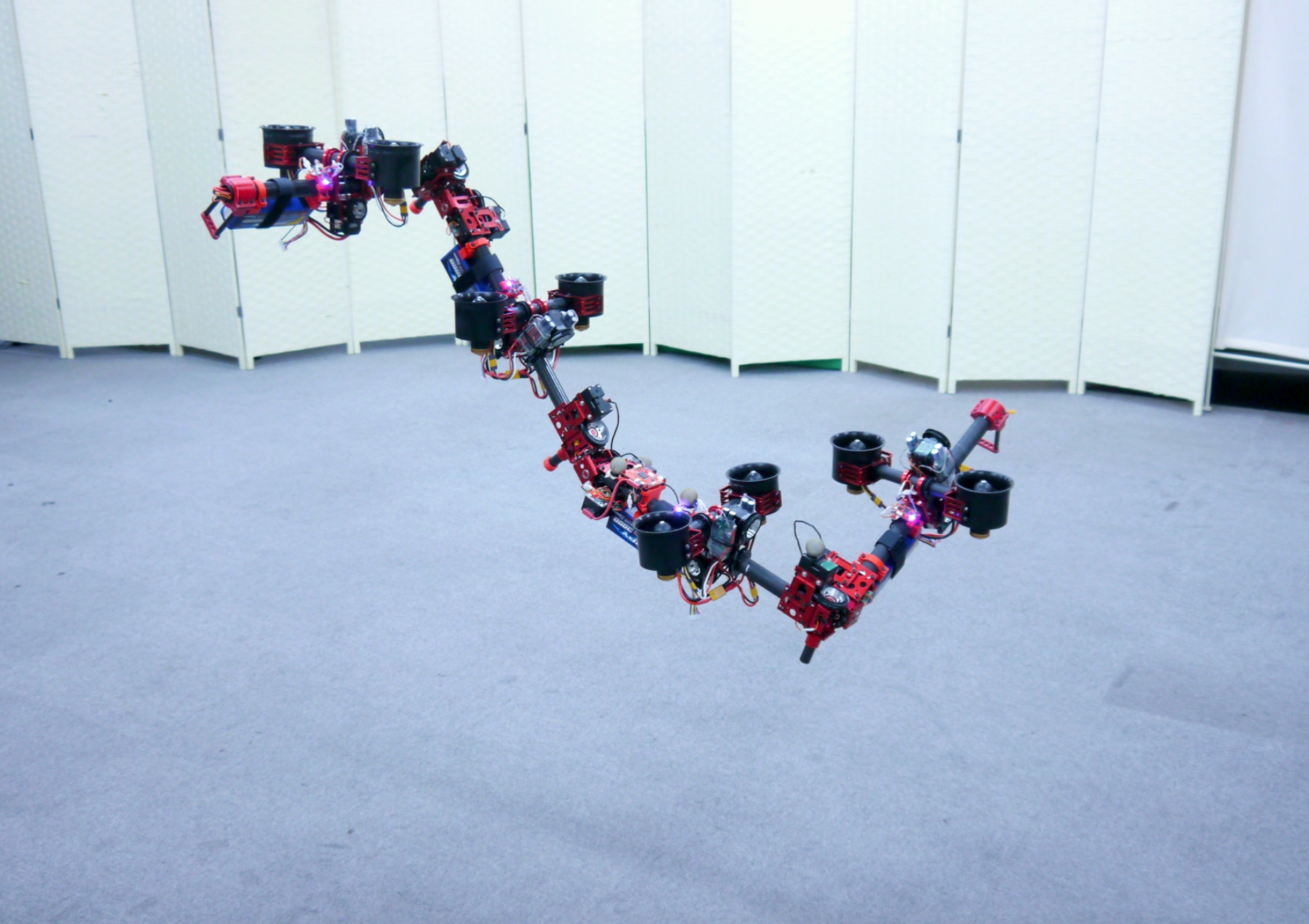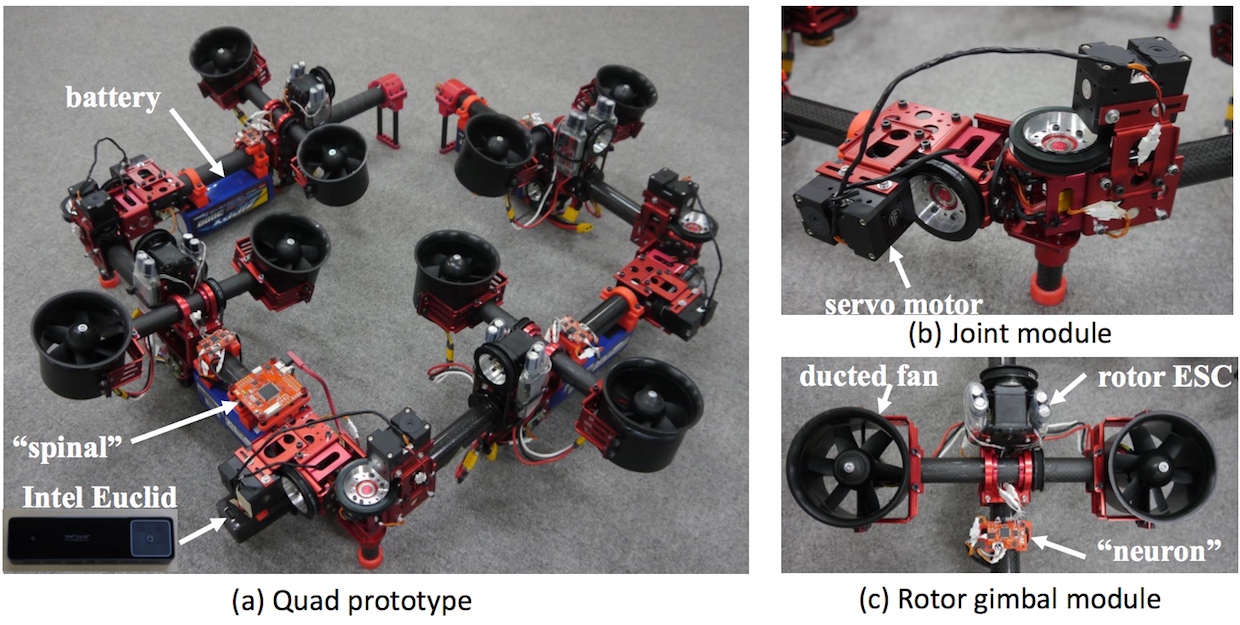Flying robot changes shape in the air
UAVs are capable of many things: from filming reports and weddings to monitoring forests in order to quickly respond to fires, and to monitor the status of power grids and oil pipelines. Potentially flying robots can be used indoors, but for this they must be both brisk and powerful enough to interact with the environment. To do this, Japanese experts have created a modular robot DRAGON, which resembles a flying tentacle, which changes shape in order to penetrate small holes and in the future act as a manipulator.

During rescue operations, the robot may need to penetrate the door, and then overcome many other dangerous obstacles - do not crash into a wall, cabinet, ficus or person. To solve this problem, you can make a very small robot that would fly into any slot. But he will fit only for observation. You can equip the drone with a protective frame - but such a bulky drone will not be able to interact with the environment very well, that is, it will only help you again for search operations. Ideally, the robot should be both small and nimble, but at the same time powerful enough.
In the JSK LabThe University of Tokyo's robotics created the DRAGON robot, which stands for Dual-rotor embedded multilink Aerial transformed aerial transformed with multi-deGree-of-freedom. The modular apparatus changes its shape on the fly - from a square copter it is transformed into a thin snake, which allows it to penetrate narrow passages, or take another shape.
DRAGON consists of modules, each of which is equipped with a pair of fans in the annular fairing. The fans change their position, forcing the modules to move in different directions, so that the robot can fly in almost any form that will allow it to make degrees of freedom. Modules are connected by hinged fasteners. The device is based on the compact computer Intel Euclid. The battery lasts for three minutes of flight, and scientists will have to work on improving this indicator. It can be assumed that the device will be recorded by cable, but in this case it will lose in maneuverability, or other autonomous power sources will be found.

A prototype of four modules, equipped with a total of eight fans. One of the tasks of the developers was to design software that allows the robot to independently decide what form to take in a particular case. In the video, the developers demonstrated how a robot in the form of a snake flies through a small “hatch”.
In the future, the robot will consist of twelve modules, and at the same time will be able to lift objects using extreme modules as a two-finger grip. It can be assumed that such a robot can encircle the object in order to transfer it, or otherwise interact with the environment.
Flying robots are used for rescue and monitoring operations. In open spaces, quadrocopters can throw a lifeline to a drowning person , deliver a defibrillator to a person , monitor what is happening in order to find lost people and monitor the area during emergencies for quick response. In the case of closed rooms, there are prototypes of snake-like robots - for example, a soft robot from researchers at Stanford Universitywhich changes its size, stretches, bends and wraps objects, rises to a great height, is able to crawl into very small cracks or, for example, under a box up to 100 kilograms to lift it. The soft shell even runs through sharp objects like nails and changes shape - pumps pump air into the body.
The 8-meter apparatus from Japanese developers from Tohoku University was created to search for people during earthquakes. The robot moves at a speed of up to 10 centimeters per second, “turning” a bristly surface. An early version of this robot was used during the liquidation of the consequences of the disaster at the Fukushima nuclear power plant , but it was moving mainly in one direction - forward. The new robot turned out to be more mobile.
There have been attempts to combine flying and snake-like robots. A quadcopter from the University of Pennsylvania scientists delivers two snake-like robots to the scene of the incident, which can move up or down the stairs.
The prototype from the JSK Lab will combine the virtues of flying robots with snake-like ones and will interact in various ways with objects, instead of being engaged only in observation. A member of the JSK laboratory describes DRAGON as “breakthrough in terms of structural design” and “an ideal platform for air manipulators”.

During rescue operations, the robot may need to penetrate the door, and then overcome many other dangerous obstacles - do not crash into a wall, cabinet, ficus or person. To solve this problem, you can make a very small robot that would fly into any slot. But he will fit only for observation. You can equip the drone with a protective frame - but such a bulky drone will not be able to interact with the environment very well, that is, it will only help you again for search operations. Ideally, the robot should be both small and nimble, but at the same time powerful enough.
In the JSK LabThe University of Tokyo's robotics created the DRAGON robot, which stands for Dual-rotor embedded multilink Aerial transformed aerial transformed with multi-deGree-of-freedom. The modular apparatus changes its shape on the fly - from a square copter it is transformed into a thin snake, which allows it to penetrate narrow passages, or take another shape.
DRAGON consists of modules, each of which is equipped with a pair of fans in the annular fairing. The fans change their position, forcing the modules to move in different directions, so that the robot can fly in almost any form that will allow it to make degrees of freedom. Modules are connected by hinged fasteners. The device is based on the compact computer Intel Euclid. The battery lasts for three minutes of flight, and scientists will have to work on improving this indicator. It can be assumed that the device will be recorded by cable, but in this case it will lose in maneuverability, or other autonomous power sources will be found.

A prototype of four modules, equipped with a total of eight fans. One of the tasks of the developers was to design software that allows the robot to independently decide what form to take in a particular case. In the video, the developers demonstrated how a robot in the form of a snake flies through a small “hatch”.
In the future, the robot will consist of twelve modules, and at the same time will be able to lift objects using extreme modules as a two-finger grip. It can be assumed that such a robot can encircle the object in order to transfer it, or otherwise interact with the environment.
Flying robots are used for rescue and monitoring operations. In open spaces, quadrocopters can throw a lifeline to a drowning person , deliver a defibrillator to a person , monitor what is happening in order to find lost people and monitor the area during emergencies for quick response. In the case of closed rooms, there are prototypes of snake-like robots - for example, a soft robot from researchers at Stanford Universitywhich changes its size, stretches, bends and wraps objects, rises to a great height, is able to crawl into very small cracks or, for example, under a box up to 100 kilograms to lift it. The soft shell even runs through sharp objects like nails and changes shape - pumps pump air into the body.
The 8-meter apparatus from Japanese developers from Tohoku University was created to search for people during earthquakes. The robot moves at a speed of up to 10 centimeters per second, “turning” a bristly surface. An early version of this robot was used during the liquidation of the consequences of the disaster at the Fukushima nuclear power plant , but it was moving mainly in one direction - forward. The new robot turned out to be more mobile.
There have been attempts to combine flying and snake-like robots. A quadcopter from the University of Pennsylvania scientists delivers two snake-like robots to the scene of the incident, which can move up or down the stairs.
The prototype from the JSK Lab will combine the virtues of flying robots with snake-like ones and will interact in various ways with objects, instead of being engaged only in observation. A member of the JSK laboratory describes DRAGON as “breakthrough in terms of structural design” and “an ideal platform for air manipulators”.
